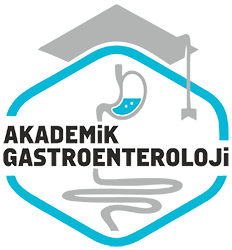Agustos 2013
Gastrik preneoplastik bulgularin kolon polibi ile ilişkisi
The relationship between gastric preneoplastic findings and colon polyps
- Ana Sayfa
- Sayılar
- Agustos 2013
- Gastrik preneoplastik bulgularin kolon polibi ile ilişkisi...
Özet
Giriş ve Amaç: Helicobacter pylori enfeksiyonu ile kolon polibi gelisimi arasındaki ilişkiye yönelik çalışmalarda çeliskili sonuçlar elde edilmıştır. Mide için preneoplastik olduğu bilinen atrofi ve intestinal metaplazi ile kolon polibi gelisimi arasındaki ilişki ise henüz yeterince irdelenmemis-tir. Iki merkezde yürütmüs olduğumuz çalışmada, gastrik preneoplastik bulgu varligi ile kolon polibi arasındaki ilişkiyi araştırmayı amaçladık. Gereç ve Yöntem:Kirikkale Üniversitesi Tıp Fakültesi ve Kirikkale Yüksek Ihtisas Hastanesi Gastroenteroloji polikliniklerine 01.01.2012 ile 01.09.2012 tarihleri arasında basvuraran hastalardan özofagogastroduodenoskopi yapilarak Helicobacter pylori için biyopsi örneği alinan ve es zamanli kolonoskopi islemi yapılan olgular çalışmaya dahil edildi. Olgularin demografik özellikleri, polip saptanan olgularda polip karakteristikleri (büyüklük, sayi, histoloji) ve özofagogastroduodenoskopik biyopsi sonucuna göre gastrik atrofi-intestinal metaplazi ve Helicobacter pylori pozitifliği Sydney klasifikasyonuna göre kaydedildi. Bulgular:çalışmaya yaş ortalaması 57,4±13,3 olan toplam 150 (93 erkek, %62,0) olgu dahil edildi. Olgularin 51’inde (%34,0) en az 1 kolon polibi mevcuttu. Kolon polibi ve adenoma varligi için atrofi [(sırasıyla; OR:3,1 (p=0,01) ve OR:3,2 (p=0,02)] bağımsız risk faktörü idi. Toplam adenomatöz polip çapi atrofinin derecesi (p=0,04) ve intestinal metaplazinin derecesi (p=0,01) ile, toplam adenom sayisi ise atrofinin derecesi (p=0,01), intestinal metaplazinin derecesi (p<0,001) ile korele idi. Sonuç:Çalışmamızda; gastrik atrofi kolon polibi/adenom gelisimi için bağımsız risk faktörü olarak bulundu. Helicobacter pylori pozitifliğinin kolon polibi varligi ile ilişkisi saptanmadi. Gastrik preneoplastik lezyonlar ile kolon neoplazisi arasındaki ilişkinin konfirme edilebilmesi için genis ölçekli, popülasyon tabanli çalışmalara ihtiyaç bulunmaktadır.
Abstract
Background and Aims: There are conflicting data regarding the relationship of Helicobacter pylori infection and the development of colon polyp. Although it is known that gastric atrophy and intestinal metaplasia are gastric preneoplastic findings, to date, the relationship between these findings and colonic polyp development has not been studied sufficiently. In our two-center study, we aimed to study the association between gastric preneoplastic lesions and the occurrence of colonic polyp. Materials and Methods:The patients who admitted to the Gastroenterology Outpatient Clinics of Kirikkale University Faculty of Medicine and Kirikkale Yüksek Ihtisas Hospital from January 1, 2012 to September 1, 2012 and underwent routine colonoscopy and had gastric biopsies taken for Helicobacter pylori infection on esophagogastroduodenoscopy were enrolled in the study. Patient demographic data (gender and age), information on colon polyp characteristics (size, number of polyps, and histology), and the presence and density of Helicobacter pylori, gastric atrophy and intestinal metaplasia in gastric biopsies according to Sydney classification were recorded. Results:The study group included 150 patients (males: 93, 62,0%), and the mean age of the participants was 57,4±13,3 years. Fifty-one (34,0%) of the patients had at least one colon polyp. Gastric atrophy was an independent risk factor for the development of colon polyp and adenoma (odds ratio: 3,1 (p=0,01) and odds ratio: 3,2 (p=0,02), respectively). Total adenomatous polyp size and the density of gastric atrophy (p=0,04) and of intestinal metaplasia were positively correlated (p=0,01). The total number of colonic adenomas was positively correlated with the density of atrophy (p=0,01) and of intestinal metaplasia (p<0,001). Conclusions:In our study, gastric atrophy was an independent risk factor for the development of colon polyp/adenoma. The presence of Helicobacter pylori was not related with the development of colon polyp or adenoma. Large, population-based studies are required to confirm the relationship between gastric preneoplastic findings and the development of colon polyp.



